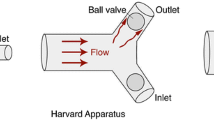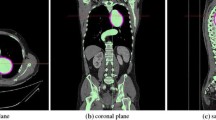Abstract
Cardiovascular disease is the primary cause of morbidity and mortality in the western world. Complex hemodynamics plays a critical role in the development of aortic dissection and atherosclerosis, as well as many other diseases. Since fundamental fluid mechanics are important for the understanding of the blood flow in the cardiovascular circulatory system of the human body aspects, a joint experimental and numerical study was conducted in this study to determine the distributions of wall shear stress and pressure and oscillatory WSS index, and to examine their correlation with the aortic disorders, especially dissection. Experimentally, the Phase-Contrast Magnetic Resonance Imaging (PC-MRI) method was used to acquire the true geometry of a normal human thoracic aorta, which was readily converted into a transparent thoracic aorta model by the rapid prototyping (RP) technique. The thoracic aorta model was then used in the in vitro experiments and computations. Simulations were performed using the computational fluid dynamic (CFD) code ACE+® to determine flow characteristics of the three-dimensional, pulsatile, incompressible, and Newtonian fluid in the thoracic aorta model. The unsteady boundary conditions at the inlet and the outlet of the aortic flow were specified from the measured flowrate and pressure results during in vitro experiments. For the code validation, the predicted axial velocity reasonably agrees with the PC-MRI experimental data in the oblique sagittal plane of the thoracic aorta model. The thorough analyses of the thoracic aorta flow, WSSs, WSS index (OSI), and wall pressures are presented. The predicted locations of the maxima of WSS and the wall pressure can be then correlated with that of the thoracic aorta dissection, and thereby may lead to a useful biological significance. The numerical results also suggest that the effects of low WSS and high OSI tend to cause wall thickening occurred along the inferior wall of the aortic arch and the anterior wall of the brachiocephalic artery, similar implication reported in a number of previous studies.









Similar content being viewed by others
References
Caro, C. G., J. M. Fitzgerald, and R. C. Schroter. Atheroma and arterial wall shear observations, correlation and proposal of a shear dependent mass transfer mechanism for atherogenesis. Biol. Sci. 177:109–133, 1971.
Cheng, C. P., R. J. Herfkens, and C. A. Taylor. Inferior vena caval hemodynamics quantified in vivo at rest and during cycling exercise using magnetic resonance imaging. Am. J. Physiol. Heart Circ. Physiol. 284:1161–1167, 2002.
Chung, K. Y., G. Belfort, W. A. Edelstein, and X. Li. Dean vortices in curved tube flow: 5–3–D MRI and numerical analysis of the velocity field. AIChE J. 39:1592–1602, 1993.
Danny, B., R. Edmond, and G. Morteza. Vortex shedding as a mechanism for free emboli formation in mechanical heart valves. ASME J. Biomech. Eng. 122:125–134, 2000.
Davies, R. R., L. J. Goldstein, and M. A. Coady. Yearly rupture or dissection rates for thoracic aortic aneurysms: simple prediction based on size. Ann. Thorac. Surg. 73:17–27, 2002.
De, S. M., Y. Moshkovitz, J. Butany, and T. E. David. Histologic abnormalities of the ascending aorta and pulmonary trunk in patients with bicuspid aortic valve disease: clinical relevance to the Ross procedure. J. Thorac. Cardiovasc. Surg. 118:588–594, 1999.
Debakey, M. E., C. H. McCollum, E. S. Crawford, J. Howell, G. P. Noon, and G. L. Lawrie. Dissection and dissecting aneurysms of the aorta: twenty-one year follow-up of 527 patients treated surgically. Surgery 92:1118–1134, 1982.
Doroghazi, R. M., and E. E. Slater. Aortic Dissection. New York: McGraw-Hill, p. 38, 1983.
Dunmire, B., K. W. Beach, K. H. Labs, M. Plett, and D. E. Strandness. Cross-beam vector Doppler ultrasound for angle-independent velocity measurements. Ultrasound Med. Biol. 26:1213–1235, 2000.
Erbel, R., H. Delert, and J. Meyer. Effect of medical and surgical therapy on aortic dissection evaluated by transesophageal echocardiography: implications for prognosis and therapy. Circulation 87:1604–1615, 1993.
Fontaine, A. A., R. S. Heinrich, and P. G. Walker. Comparison of magnetic resonance imaging and laser Doppler anemometry velocity measurements downstream of replacement heart valves: implications for in vivo assessment of prosthetic valve function. J. Heart Valve Dis. 5:66–73, 1996.
Fung, Y. C. Biomechanics. Mechanical Properties of Living Tissues. New York: Springer, 1981.
Gao, F., M. Watanabe, and T. Matsuzawa. Stress analysis in a layered aortic arch model under pulsatile blood flow. Biomed. Eng. Online 5:25, 2006.
Gerdes, A., E. Joubert-Hubner, K. Esders, and H. H. Sievers. Hydrodynamics of aortic arch vessels during perfusion through the right subclavian artery. Ann. Thorac. Surg. 69:1425–1430, 2000.
Gnasso, A., C. Irace, C. Carallo, M. S. De Franceschi, C. Motti, P. L. Mattioli, and A. Pujia. In vivo association between low wall shear stress and plaque in subjects with asymmetrical carotid atherosclerosis. Stroke 28:993–998, 1997.
Halme, T., T. Savunen, H. Aho, T. Vihersaari, and R. Penttinen. Elastin and collagen in the aortic wall: changes in the Marfan syndrome and annuloaortic ectasia. Exp. Mol. Pathol. 43:1–12, 1985.
Jin, S., J. Oshinski, and D. P. Giddens. Effects of wall motion and compliance on flow patterns in the ascending aorta. ASME J. Biomech. Eng. 125:347–354, 2003.
Kilner, P. J., G. Z. Yang, R. H. Mohiaddin, D. N. Firmin, and D. B. Longmore. Helical and retrograde secondary flow patterns in the aortic arch studied by three-dimensional magnetic resonance velocity mapping. Circulation 88:2235–2247, 1993.
Kim, Y. H., J. E. Kim, Y. Ito, A. M. Shih, B. Brott, and A. Anayiotos. Hemodynamic analysis of a compliant femoral artery bifurcation model using a fluid structure interaction framework. Ann. Biomed. Eng. 36:1753–1763, 2008.
Lee, D., and J. Y. Chen. Numerical simulation of flow fields in a tube with two branches. J. Biomech. 33:1305–1312, 2000.
Liepsch, D., S. T. Moravec, and R. Baumgart. Some flow visualization and laser-Doppler velocity measurements in a tube-to-scale elastic model of a human arotic arch—a new model technique. Biorheology 29:563–580, 1992.
Light, E. D., R. E. Davidsen, J. O. Fiering, T. A. Hruschka, and S. W. Smith. Progress in two-dimensional arrays for real-time volumetric imaging. Ultrason. Imaging 20:1–15, 1998.
Lima, R., S. Wada, M. Takeda, K. Tsubota, and T. Yamaguchi. In vitro confocal micro-PIV measurements of blood flow in a square microchannel: the effect of the hematocrit on instantaneous velocity profiles. J. Biomech. 40:2752–2757, 2007.
Loth, F., P. F. Fischer, N. Arslan, C. D. Bertram, S. E. Lee, T. J. Royston, W. E. Shaalan, and H. S. Bassiouny. Transitional flow at the venous anastomosis of an arteriovenous graft: Potential activation of the erk1/2 mechanotransduction pathway. ASME J. Biomech. Eng. 125:49–61, 2003.
Malek, A. M., S. L. Alper, and S. Izumo. Hemodynamic shear stress and its role in atherosclerosis. J. Am. Med. Assoc. 282:2035–2042, 1999.
Mitten, S. P., S. P. Simmons, and F. Najjar. Numerical study of pulsatile flow in a constricted channel. J. Fluid Mech. 485:337–378, 2003.
Nakamura, M., S. Wada, and T. Yamaguchi. Computational analysis of blood flow in an integrated model of the left ventricle and the aorta. ASME J. Biomech. Eng. 128:837–843, 2006.
Nerem, R. M. Vascular fluid mechanics, the arterial wall, and atherosclerosis. J. Biomech. Eng. 114:274–282, 1992.
Niu, Y. Y., C. H. Chang, W. Y. Tseng, H. H. Peng, and H. Y. Yu. Numerical simulation of an aortic flow based on a HLLC type incompressible flow solver. Commun. Comput. Phys. 5:142–162, 2009.
Rayz, V. L., L. Boussel, M. T. Lawton, G. Acevedo-Bolton, L. Ge, W. L. Young, R. T. Higashida, and D. Saloner. Numerical modeling of the flow in intracranial aneurysms prediction of regions prone to thrombus formation. Ann. Biomed. Eng. 36:1793–1804, 2008.
Ringgaard, S., R. M. Botnar, and C. Djurhuus. High-resolution assessment of velocity fields and shear stresses distal to prosthetic heart valves using high-field magnetic resonance imaging. J. Heart Valve Dis. 8:96–103, 1999.
Roberts, W. C. Aortic dissection: anatomy consequences and causes. Am. Heart J. 101:195–214, 1981.
Sawabe, M., R. Takahashi, S. Matsushita, T. Ozawa, T. Arai, A. Hamamatsu, K. Nakahara, K. Chida, H. Yamanouchi, S. Murayama, and N. Tanaka. Aortic pulse wave velocity and the degree of atherosclerosis in the elderly: a pathological study based on 304 autopsy cases. Atherosclerosis 179:345–351, 2005.
Sayers, R. D. Aortic aneurysms, inflammatory pathways and nitric oxide. Ann. R. Coll. Surg. Engl. 84:239–246, 2002.
Shahcheraghi, N., H. A. Dwyer, A. Y. Cheer, A. I. Barakat, and T. Rutaganira. Unsteady and three-dimensional simulation of blood flow in the human aortic arch. ASME J. Biomech. Eng. 124:378–387, 2002.
Svensson, L. G., and E. S. Grawford. Aortic dissection and aortic aneurysm surgery: clinical observations, experimental investigations, and statistical analyses. Part II. Curr. Probl. Surg. 29:913–1057, 1992.
Tam, A. S. M., M. C. Sapp, and M. R. Roach. The effect of tear depth on the propagation of aortic dissections in isolated porcine thoracic aorta. J. Biomech. 31:673–676, 1998.
Taylor, C. A., C. P. Cheng, L. A. Espinosa, B. T. Tang, D. Parker, and R. J. Herfkens. In vivo quantification of blood flow and wall shear stress in the human abdominal aorta during lower limb exercise. Ann. Biomed. Eng. 30:402–408, 2002.
Thubrikar, M. J., P. Agali, and F. Robicsek. Wall stress as a possible mechanism for the development of transverse intimal tears in aortic dissections. J. Med. Eng. Technol. 23:127–134, 1999.
Van-Doormaal, J. P., and G. D. Raithby. Enhancements of the SIMPLE method for predicting incompressible fluid flows. Numer. Heat Transfer 7:147–163, 1984.
Vande Geest, J. P., D. E. Schmidt, M. S. Sacks, and D. A. Vorp. The effects of anisotropy on the stress analyses of patient-specific abdominal aortic aneurysms. Ann. Biomed. Eng. 36:921–932, 2008.
Wagner, R. H., J. Krenzien, and A. Gussmann. Midterm results of endovascular stent graft treatment for descending aortic aneurysms including high-risk patients. Ger. Med. Sci. 4:1–6, 2006.
Walker, P. G., E. M. Pedersen, and S. Oyre. Magnetic resonance velocity imaging: a new method for prosthetic heart valve study. J. Heart Valve Dis. 4:296–307, 1995.
Whitmore, R. L. Rheology of the Circulation. Oxford: Pergamon Press, 1968.
Yearwood, T. L. Steady and pulsatile flow analysis in a model of the human aortic arch. Ph.D. thesis, Tulane University, New Orleans, 1979.
Yee, C. A. Aortic dissection: the tear that kills. Nurs. Manage 35:25–32, 2004.
Yu, H. Y., H. H. Peng, J. L. Wang, C. Y. Wen, and W. Y. I. Tseng. Quantification of the pulse wave velocity of the descending aorta using axial velocity profiles from phase- contrast magnetic resonance imaging. Magn. Reson. Med. 56:876–883, 2006.
Acknowledgment
This study was supported by National Science Council of Taiwan under Grant Number NSC96-2628-E-006-252-MY3. No benefits in any form have been received or will be received from a commercial party related directly or indirectly to the subject of this article.
Author information
Authors and Affiliations
Corresponding author
Rights and permissions
About this article
Cite this article
Wen, CY., Yang, AS., Tseng, LY. et al. Investigation of Pulsatile Flowfield in Healthy Thoracic Aorta Models. Ann Biomed Eng 38, 391–402 (2010). https://doi.org/10.1007/s10439-009-9835-6
Received:
Accepted:
Published:
Issue Date:
DOI: https://doi.org/10.1007/s10439-009-9835-6




